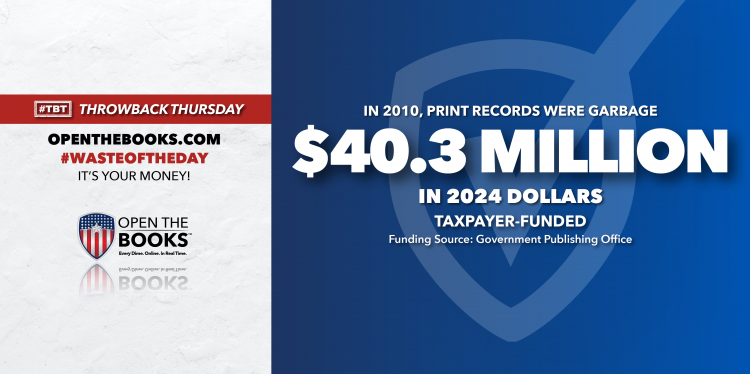Executive
Waste of the Day: Government Printing Ended Up in the Trash
The government continues to print the Congressional Record despite its online availability, wasting $28 million in 2010 to produce copies that mostly ended up in the trash. With a current subscription cost of $503 and a $136 million funding request for 2025, this practice highlights significant inefficiencies in federal spending.

Topline: Less is more when it comes to writing, but government publishers might need to retake their English courses.
The government printed volumes of records…
The Congressional Record has been available online since 2005, but that has not stopped the Government Publishing Office from spending money to produce a print version summarizing every debate and vote held in Congress.
In 2010 the government spent $28 million to print 4,551 copies every day, most of which reportedly were thrown away. The money would be worth $40.3 million today.
That’s according to the “Wastebook” reporting published by the late U.S. Senator Dr. Tom Coburn. For years, these reports shined a white-hot spotlight on federal frauds and taxpayer abuses.
Coburn, the legendary U.S. Senator from Oklahoma, earned the nickname “Dr. No” by stopping thousands of pork-barrel projects using the Senate rules. Projects that he couldn’t stop, Coburn included in his oversight reports.
Coburn’s Wastebook 2010 included 100 examples of outrageous spending worth more than $11.5 billion, including the $28 million spent to print 4,551 copies every day.

… and threw most of them away
Key facts: There were 174 Congressional Records published in 2010 of varying length. Some were three pages long, some were 300.
Regardless of length, Coburn claimed that the majority went “directly into the trash.”
And if legislators like Coburn viewed the print version as redundant back in 2010, just think of how antiquated it became as the internet became even more widespread in recent years, and the government continued to spend money on printing the dense documents.
Today, Congressional Records as far back as 1875 have been digitized.
Search all federal, state and local government salaries and vendor spending with the AI search bot, Benjamin, at OpenTheBooks.com.
Summary: The Congressional Record is still available in print, but now they’re charging for it: a one-year subscription from the U.S. Government Bookstore costs $503. The Government Publishing Office requested $136 million in funding for 2025. The budget request is, of course, available in print.
The #WasteOfTheDay is brought to you by the forensic auditors at OpenTheBooks.com.
This article was originally published by RCI and made available via RealClearWire.
Jeremy Portnoy, former reporting intern at Open the Books, is now a full-fledged investigative journalist at that organization. With the death of founder Adam Andrzejewki, he has taken over the Waste of the Day column.
-

 Civilization3 days ago
Civilization3 days agoDC Pipe Bomb Arrest Raises Questions About Christopher’s Wray’s FBI
-

 Civilization4 days ago
Civilization4 days agoThe Legal Logic Behind U.S. Operations Against Narco-Terrorist Networks
-

 Guest Columns5 days ago
Guest Columns5 days agoCongressional Leaders See Far Higher Stock Returns Than Peers
-

 Civilization5 days ago
Civilization5 days agoHow Trump Changed America
-

 Executive4 days ago
Executive4 days agoNewsom’s ‘National Model’ for Homeless Wracked by Fraud
-

 Executive3 days ago
Executive3 days agoWhen You’re in a Hole, Stop Digging
-

 Education2 days ago
Education2 days agoWaste of the Day: Taxpayers Subsidize Football Coach Severance
-

 Civilization2 days ago
Civilization2 days agoPence Calls on Trump To Fire RFK Jr Over Abortion Drug








